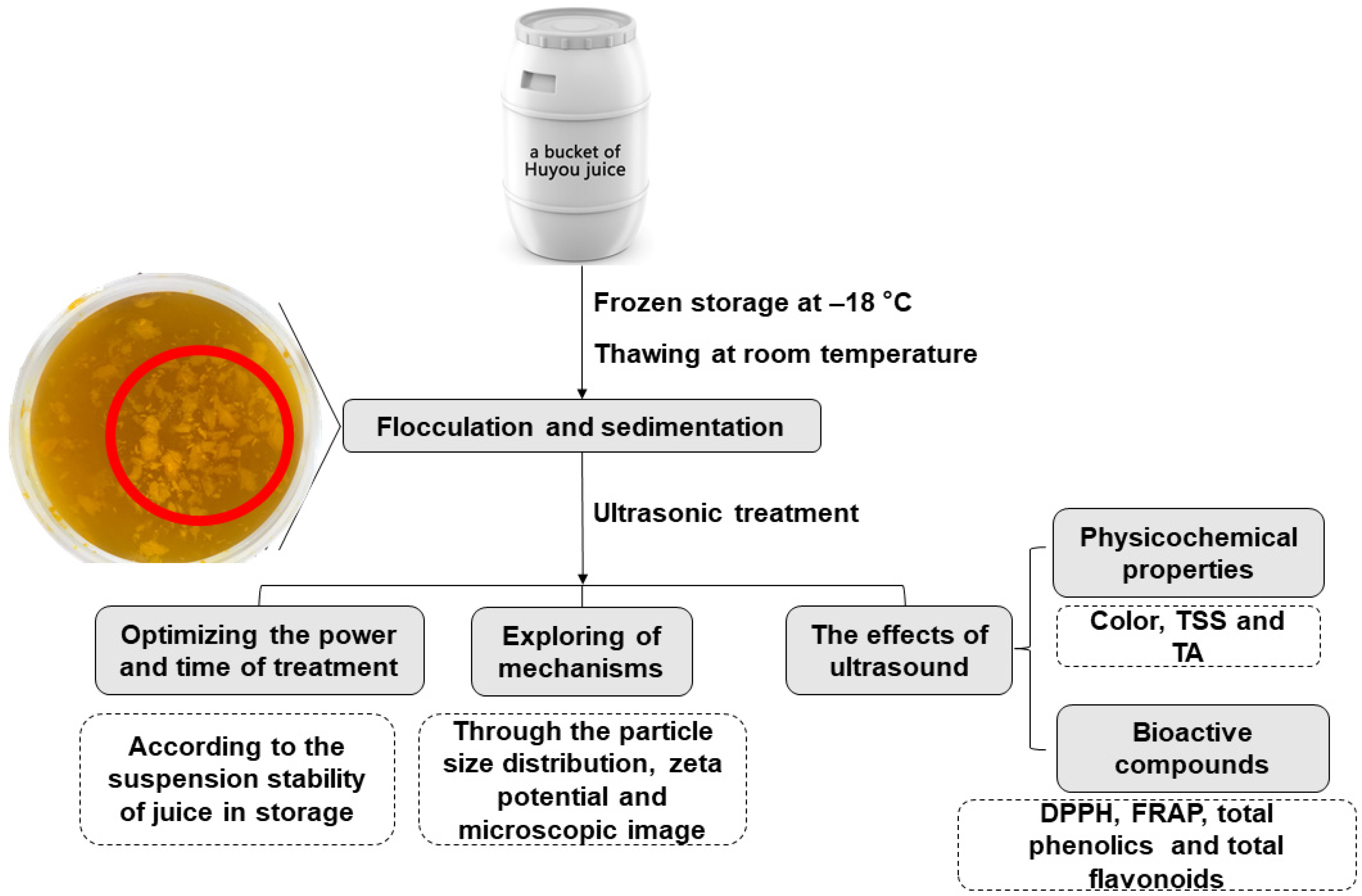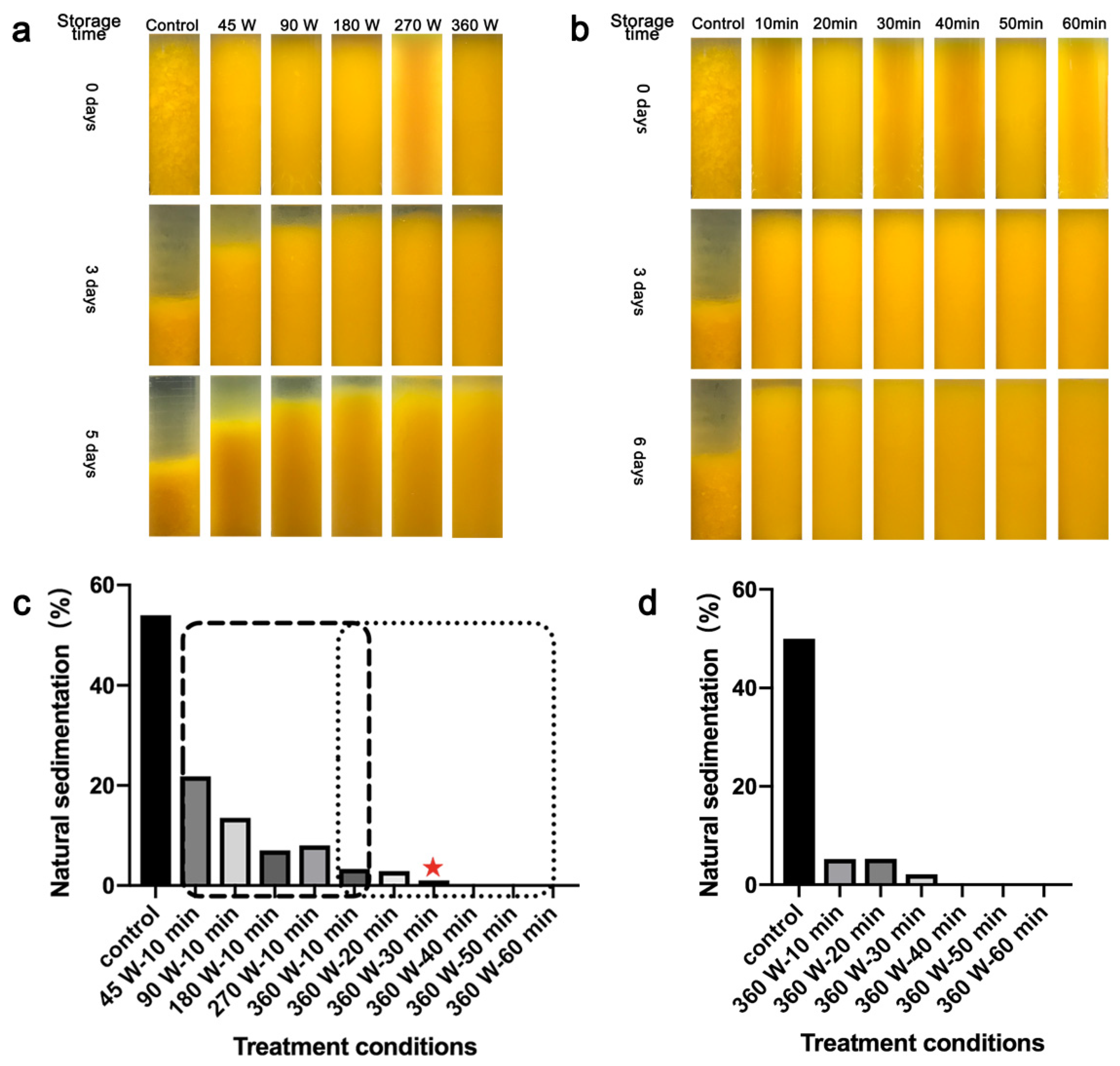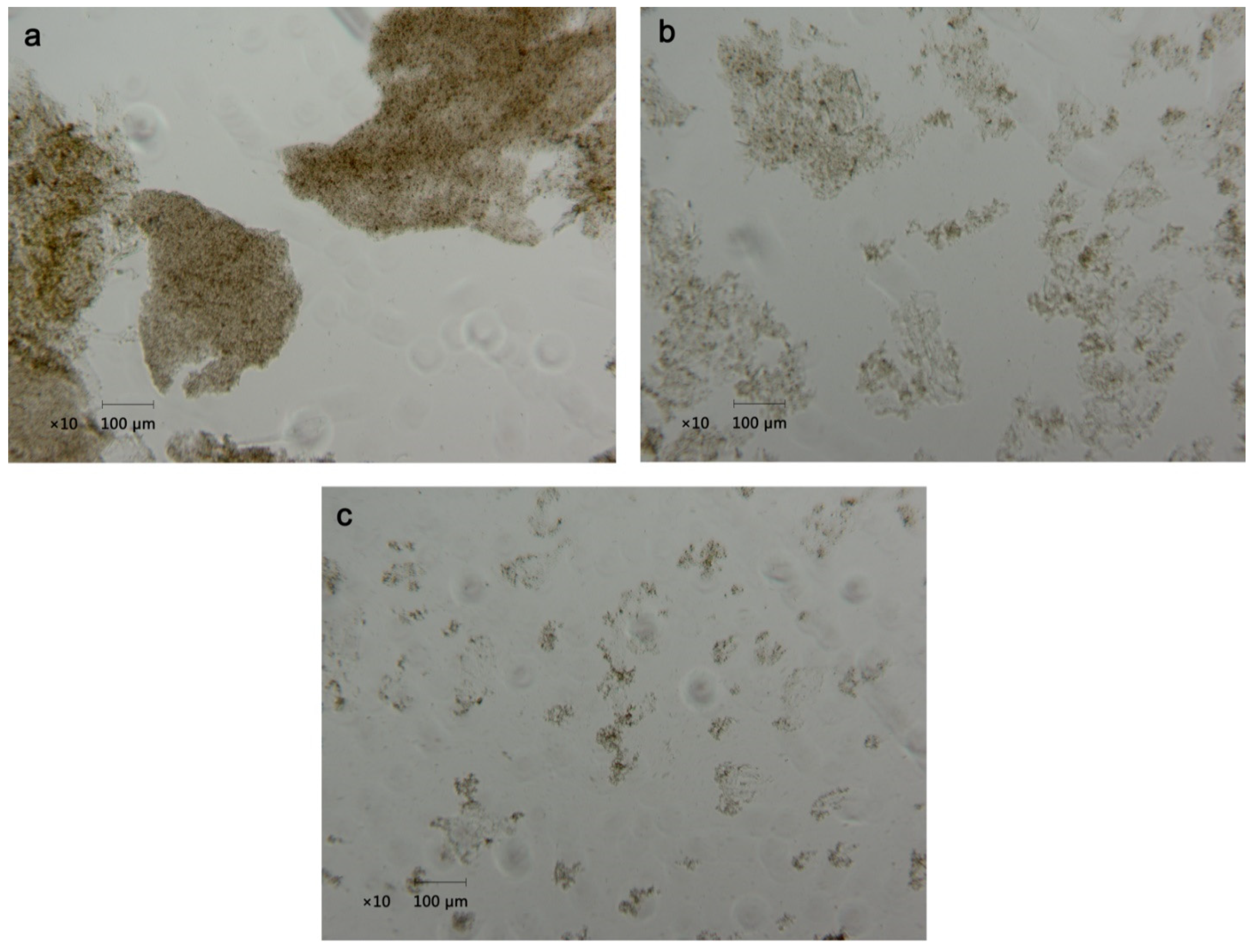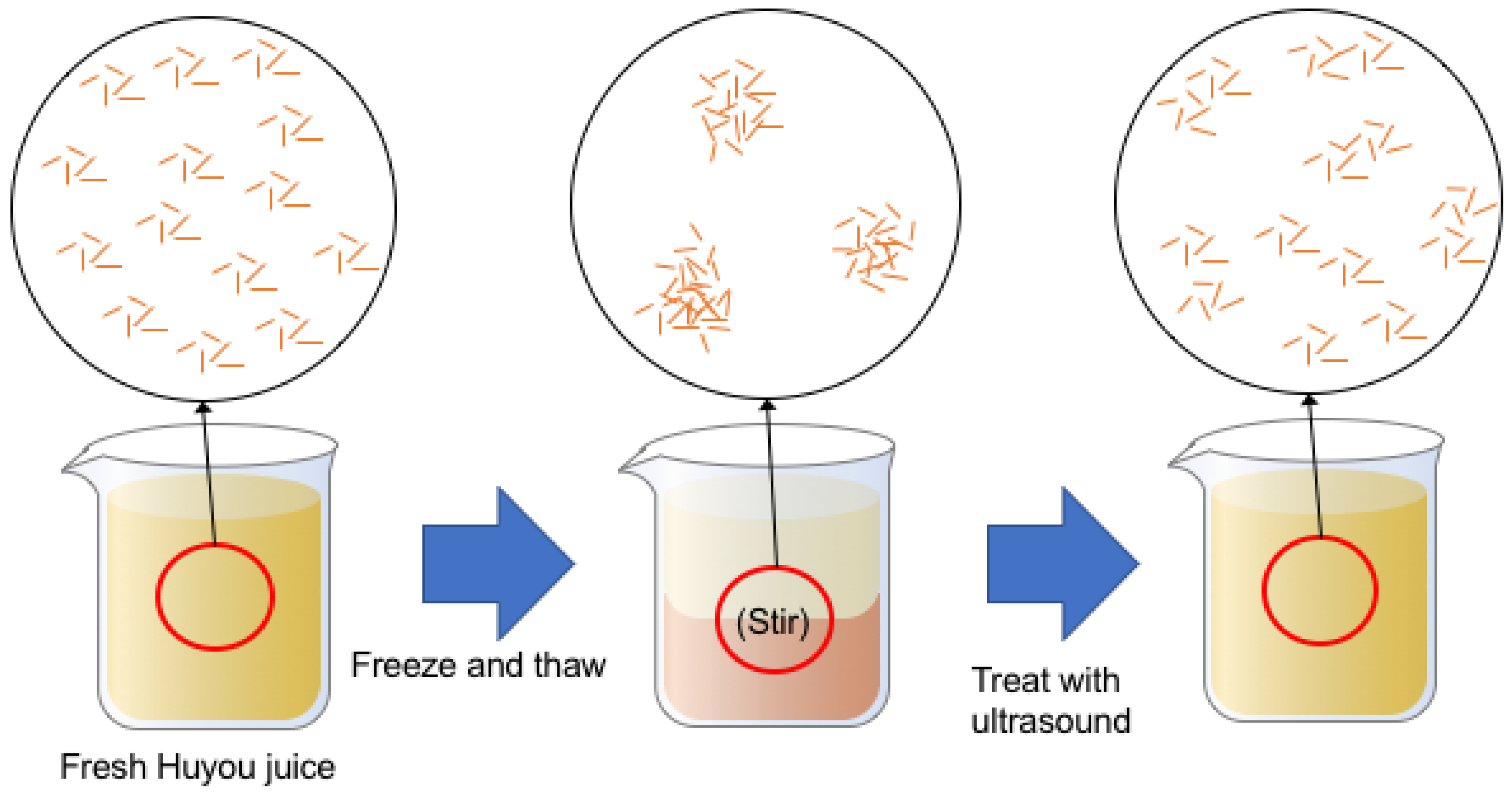Ultrasonication of Thawed Huyou Juice: Effects on Cloud Stability, Physicochemical Properties and Bioactive Compounds
Abstract
:1. Introduction
2. Materials and Methods
2.1. Materials
2.2. Ultrasonic Treatment
2.3. Observation and Measurement of Sedimentation Behavior
2.4. Color Analysis
2.5. Total Soluble Solids (TSS) and Titratable Acidity (TA)
2.6. Antioxidant Activity
2.6.1. 1,1-Diphenyl-2-picrylhydrazyl (DPPH) Radical Scavenging Activity
2.6.2. The Ferric Reducing Ability of Plasma (FRAP)
2.7. Phenolic Content
2.7.1. Total Phenolics Content
2.7.2. Total Flavonoids Content
2.7.3. Flavanone Composition
2.8. Particle Size Distribution and Zeta-Potential
2.9. Optical Microscopic Observation
2.10. Experimental Design and Statistical Analysis
3. Results
3.1. Cloud Stability
3.2. Particle Size and Zeta Potential
3.2.1. Particle Size Distribution and Microscopic Images
3.2.2. Zeta Potential
3.3. Physicochemical Properties
3.4. Bioactive Compounds
4. Conclusions
Supplementary Materials
Author Contributions
Funding
Institutional Review Board Statement
Informed Consent Statement
Data Availability Statement
Conflicts of Interest
References
- Xu, C.J.; Bao, L.; Zhang, B.; Bei, Z.M.; Ye, X.Y.; Zhang, S.L.; Chen, K.S. Parentage analysis of huyou (Citrus changshanensis) based on internal transcribed spacer sequences. Plant Breed. 2006, 125, 519–522. [Google Scholar] [CrossRef]
- Sun, C.; Chen, K.; Chen, Y.; Chen, Q. Contents and antioxidant capacity of limonin and nomilin in different tissues of citrus fruit of four cultivars during fruit growth and maturation. Food Chem. 2005, 93, 599–605. [Google Scholar] [CrossRef]
- Guo, Y.W.; Hu, Y.H.; Liu, J.; Li, H.; Li, X.W. Chemical Constituents from Citrus changshan-huyou and Their Anti-Inflammatory Activities. Chem. Biodivers. 2020, 17, e2000503. [Google Scholar]
- Guihua, X.U.; Liu, D.; Chen, J.; Xingqian, Y.E.; Shi, J. Composition of major flavanone glycosides and antioxidant capacity of three citrus varieties. J. Food Biochem. 2010, 33, 453–469. [Google Scholar]
- Guo, J.; Gao, Z.; Li, G.; Fu, F.; Liang, Z.; Zhu, H.; Shan, Y. Antimicrobial and antibiofilm efficacy and mechanism of essential oil from Citrus Changshan-huyou Y. B. chang against Listeria monocytogenes. Food Control. 2019, 105, 256–264. [Google Scholar] [CrossRef]
- Lu, Y.; Zhang, C.; Bucheli, P.; Wei, D. Citrus Flavonoids in Fruit and Traditional Chinese Medicinal Food Ingredients in China. Plant Foods Hum. Nutr. 2006, 61, 55–63. [Google Scholar] [CrossRef]
- Xu, G.; Liu, D.; Chen, J.; Ye, X.; Ma, Y.; Shi, J. Juice components and antioxidant capacity of citrus varieties cultivated in China. Food Chem. 2008, 106, 545–551. [Google Scholar] [CrossRef]
- Beveridge, T. Opalescent and Cloudy Fruit Juices: Formation and Particle Stability. Crit. Rev. Food Sci. Nutr. 2002, 42, 317–337. [Google Scholar] [CrossRef] [PubMed]
- Baker, R.A.; Cameron, R.G. Clouds of citrus juices and juice drinks. Food Technol. 1999, 53, 64–69. [Google Scholar]
- Filippi, M.V.; Genovese, D.B.; Lozano, J.E. Zeta-Potential as a Way to Determine Optimal Conditions During Fruit Juice Clarification. In Food Engineering: Integrated Approaches; Springer: New York, NY, USA, 2008; pp. 391–397. [Google Scholar] [CrossRef]
- Zhu, D.; Shen, Y.; Wei, L.; Xu, L.; Cao, X.; Liu, H.; Li, J. Effect of particle size on the stability and flavor of cloudy apple juice. Food Chem. 2020, 328, 126967. [Google Scholar] [CrossRef] [PubMed]
- Wellala, C.K.D.; Bi, J.; Liu, X.; Liu, J.; Lyu, J.; Zhou, M. Effect of high pressure homogenization on mixed juice stability, rheology, physicochemical properties and microorganism reduction. J. Food Sci. Technol. 2020, 57, 1944–1953. [Google Scholar] [CrossRef]
- Lim, S.; Yagiz, Y.; Balaban, M. Continuous high pressure carbon dioxide processing of mandarin juice. Food Sci. Biotechnol. 2006, 15, 13–18. [Google Scholar]
- Ingallinera, B.; Barbagallo, R.; Spagna, G.; Palmeri, R.; Todaro, A. Effects of thermal treatments on pectinesterase activity determined in blood oranges juices. Enzym. Microb. Technol. 2005, 36, 258–263. [Google Scholar] [CrossRef]
- Merin, W.I.; Shomer, I. Structural Stability of Fresh and Frozen-Thawed’Valencia’ (C. sinensis) Orange Juice. J. Food Sci. 2010, 49, 1489–1493. [Google Scholar] [CrossRef]
- Rastogi, N.K. Opportunities and Challenges in Application of Ultrasound in Food Processing. Crit. Rev. Food Sci. Nutr. 2011, 51, 705–722. [Google Scholar] [CrossRef]
- Wang, J.; Vanga, S.K.; Raghavan, V. High-intensity ultrasound processing of kiwifruit juice: Effects on the ascorbic acid, total phenolics, flavonoids and antioxidant capacity. LWT 2019, 107, 299–307. [Google Scholar] [CrossRef]
- Jin, W.; Wang, J.; Ye, J.; Kranthi, V.S.; Vijaya, R. Influence of high-intensity ultrasound on bioactive compounds of strawberry juice: Profiles of ascorbic acid, phenolics, antioxidant activity and microstructure. Food Control. 2018, 96, 128–136. [Google Scholar]
- Ordóñez-Santos, L.E.; Martínez-Girón, J.; Arias-Jaramillo, M.E. Effect of ultrasound treatment on visual color, vitamin C, total phenols, and carotenoids content in Cape gooseberry juice. Food Chem. 2017, 233, 96–100. [Google Scholar] [CrossRef] [PubMed]
- Zinoviadou, K.G.; Galanakis, C.; Brnčić, M.; Grimi, N.; Boussetta, N.; Mota, M.; Saraiva, J.A.; Patras, A.; Tiwari, B.K.; Barba, F.J. Fruit juice sonication: Implications on food safety and physicochemical and nutritional properties. Food Res. Int. 2015, 77, 743–752. [Google Scholar] [CrossRef]
- Nafar, M.; Emam-Djomeh, Z.; Yousefi, S.; Ravan, M.H. An Optimization Study on the Ultrasonic Treatments for Saccharomyces cerevisiae Inactivation in Red Grape Juice with Maintaining Critical Quality Attributes. J. Food Qual. 2013, 36, 269–281. [Google Scholar] [CrossRef]
- Alves, L.D.L.; Santos, R.L.D.; LuíseBayer, B.; Devens, A.L.M.; Cichoski, A.J.; Mendona, C.R.B. Thermosonicationof tangerine juice: Effects on quality characteristics, bioactive compounds and antioxidant activity. J. Food Process. Preserv. 2020, 44, e14914. [Google Scholar] [CrossRef]
- Xingqian, Y. A Study on Homogenization of Peach Nectar. Food Ferment. Ind. 1992, 2. [Google Scholar]
- Gorinstein, S.; Haruenkit, R.; Park, Y.S.; Jung, S.T.; Zachwieja, Z.; Jastrzebski, Z.; Katrich, E.; Trakhtenberg, S.; Belloso, O.M. Bioactive compounds and antioxidant potential in fresh and dried Jaffa sweeties, a new kind of citrus fruit. J. Sci. Food Agric. 2004, 84, 1459–1463. [Google Scholar] [CrossRef]
- Benzie, I.; Strain, J. The Ferric Reducing Ability of Plasma (FRAP) as a Measure of “Antioxidant Power”: The FRAP Assay. Anal. Biochem. 1996, 239, 70–76. [Google Scholar] [CrossRef] [Green Version]
- Shen, Y.; Yang, H.; Chen, J.; Liu, D.; Ye, X. Effect of waxing and wrapping on phenolic content and antioxidant activity of citrus during storage. J. Food Process. Preserv. 2012, 37, 222–231. [Google Scholar] [CrossRef]
- Singleton, V.; Rossi, J.A. Colorimetry of Total Phenolics with Phosphomolybdic-Phosphotungstic Acid Reagents. Am. J. Enol. Vitic. 1965, 16, 144–158. [Google Scholar]
- Wang, W.; Wang, W.; Wang, Y.; Yang, R.; Tang, J.; Zhao, Y. Hot-air assisted continuous radio frequency heating for improving drying efficiency and retaining quality of inshell hazelnuts (Corylus avellana L. cv. Barcelona). J. Food Eng. 2020, 279, 109956. [Google Scholar] [CrossRef]
- Huang, R.; Wu, W.; Shen, S.; Fan, J.; Chang, Y.; Chen, S.; Ye, X. Evaluation of colorimetric methods for quantification of citrus flavonoids to avoid misuse. Anal. Methods 2018, 10, 2575–2587. [Google Scholar] [CrossRef]
- Igual, M.; Contreras, C.; Camacho, M.M.; Martínez-Navarrete, N. Effect of Thermal Treatment and Storage Conditions on the Physical and Sensory Properties of Grapefruit Juice. Food Bioprocess Technol. 2013, 7, 191–203. [Google Scholar] [CrossRef]
- Ertugay, M.F.; Baslar, M. The effect of ultrasonic treatments on cloudy quality-related quality parameters in apple juice. Innov. Food Sci. Emerg. Technol. 2014, 26, 226–231. [Google Scholar] [CrossRef]
- Tiwari, B.K.; Muthukumarappan, K.; O’Donnell, C.P.; Cullen, P. Effects of Sonication on the Kinetics of Orange Juice Quality Parameters. J. Agric. Food Chem. 2008, 56, 2423–2428. [Google Scholar] [CrossRef]
- Seshadri, R.; Weiss, J.; Hulbert, G.J.; Mount, J. Ultrasonic processing influences rheological and optical properties of high-methoxyl pectin dispersions. Food Hydrocoll. 2003, 17, 191–197. [Google Scholar] [CrossRef]
- Knorr, D.; Zenker, M.; Heinz, V.; Lee, D.-U. Applications and potential of ultrasonics in food processing. Trends Food Sci. Technol. 2004, 15, 261–266. [Google Scholar] [CrossRef]
- Reiter, M.; Neidhart, S.; Carle, R. Sedimentation behaviour and turbidity of carrot juices in relation to the characteristics of their cloud particles. J. Sci. Food Agric. 2003, 83, 745–751. [Google Scholar] [CrossRef]
- Nespoulous, M.; Antoni, M.; Chassigneux, C.; Denoyel, R. Porous silica beads produced by nanofluid emulsion freezing. Microporous Mesoporous Mater. 2020, 305, 110362. [Google Scholar] [CrossRef]
- Tangsuphoom, N.; Coupland, J.N. Effect of thermal treatments on the properties of coconut milk emulsions prepared with surface-active stabilizers. Food Hydrocoll. 2009, 23, 1792–1800. [Google Scholar] [CrossRef]
- Wang, J.; Wang, J.; Vanga, S.K.; Raghavan, V. High-intensity ultrasound processing of kiwifruit juice: Effects on the microstructure, pectin, carbohydrates and rheological properties. Food Chem. 2020, 313, 126121. [Google Scholar] [CrossRef]
- Gao, R.; Ye, F.; Wang, Y.; Lu, Z.; Yuan, M.; Zhao, G. The spatial-temporal working pattern of cold ultrasound treatment in improving the sensory, nutritional and safe quality of unpasteurized raw tomato juice. Ultrason. Sonochem. 2019, 56, 240–253. [Google Scholar] [CrossRef] [PubMed]
- Wu, J.; Gamage, T.V.; Vilkhu, K.S.; Simons, L.K.; Mawson, R. Effect of thermosonication on quality improvement of tomato juice. Innov. Food Sci. Emerg. Technol. 2008, 9, 186–195. [Google Scholar] [CrossRef]
- Zeng, D.; Xiao, G.; Xu, Y.; Zou, B.; Wu, J.; Yu, Y. Protein and polyphenols involved in sediment formation in cloudy litchi juice. Food Sci. Biotechnol. 2019, 28, 945–953. [Google Scholar] [CrossRef] [PubMed]
- Genovese, D.; Lozano, J. The effect of hydrocolloids on the stability and viscosity of cloudy apple juices. Food Hydrocoll. 2001, 15, 1–7. [Google Scholar] [CrossRef]
- Schultz, A.K.; Barrett, D.M.; Dungan, S.R. Effect of Acidification on Carrot (Daucus carota) Juice Cloud Stability. J. Agric. Food Chem. 2014, 62, 11528–11535. [Google Scholar] [CrossRef] [PubMed]
- Rojas, M.; Leite, T.S.; Cristianini, M.; Alvim, I.D.; Augusto, P.E. Peach juice processed by the ultrasound technology: Changes in its microstructure improve its physical properties and stability. Food Res. Int. 2016, 82, 22–33. [Google Scholar] [CrossRef]
- Shi, H.X.; Zhong, S.M. Study on Initial Identification and Stability of Natural Pigment of Citrus changshan-huyou. For. Res. 2008, 6. [Google Scholar]
- Yildiz, G.; Aadil, R.M. Comparison of high temperature-short time and sonication on selected parameters of strawberry juice during room temperature storage. J. Food Sci. Technol. 2019, 57, 1462–1468. [Google Scholar] [CrossRef] [PubMed]
- Zia, S.; Khan, M.R.; Zeng, X.A.; Shabbir, M.A.; Aadil, R.M. Combined effect of microwave and ultrasonication treatments on the quality and stability of sugarcane juice during cold storage. Int. J. Food Sci. Technol. 2019, 54, 2563–2569. [Google Scholar] [CrossRef]
- Chen, L.; Bi, X.; Cao, X.; Liu, L.; Che, Z. Effects of high-power ultrasound on microflora, enzymes and some quality attributes of a strawberry drink. J. Sci. Food Agric. 2018, 98, 5378–5385. [Google Scholar] [CrossRef]
- Chen, L.; Bi, X.; Guo, D.; Xing, Y.; Che, Z. The effect of high-power ultrasound on the quality of carrot juice. Food Sci. Technol. Int. 2019, 25, 394–403. [Google Scholar] [CrossRef]
- Anda, D.R.-D.; Ventura-Lara, M.G.; Rodríguez-Hernández, G.; Ozuna, C. The impact of power ultrasound application on physicochemical, antioxidant, and microbiological properties of fresh orange and celery juice blend. J. Food Meas. Charact. 2019, 13, 3140–3148. [Google Scholar] [CrossRef]
- Abid, M.; Jabbar, S.; Wu, T.; Hashim, M.M.; Hu, B.; Saeeduddin, M.; Zeng, X. Qualitative Assessment of Sonicated Apple Juice during Storage. J. Food Process. Preserv. 2014, 39, 1299–1308. [Google Scholar] [CrossRef]
- Mehta, D.; Sharma, N.; Bansal, V.; Sangwan, R.S.; Yadav, S.K. Impact of ultrasonication, ultraviolet and atmospheric cold plasma processing on quality parameters of tomato-based beverage in comparison with thermal processing. Innov. Food Sci. Emerg. Technol. 2019, 52, 343–349. [Google Scholar] [CrossRef]
- Chaikham, P.; Prangthip, P.; Seesuriyachan, P. Ultra-Sonication Effects on Quality Attributes of Maoberry (Antidesma bunius L.) Juice. Food Sci. Technol. Res. 2016, 22, 647–654. [Google Scholar] [CrossRef] [Green Version]
- Singanusong, R.; Nipornram, S.; Tochampa, W.; Rattanatraiwong, P. Low Power Ultrasound-Assisted Extraction of Phenolic Compounds from Mandarin (Citrus reticulata Blanco cv. Sainampueng) and Lime (Citrus aurantifolia) Peels and the Antioxidant. Food Anal. Methods 2014, 8, 1112–1123. [Google Scholar] [CrossRef]
- Yue, W.; Jing, Q.; Jinping, C.; Dengliang, W.; Chunrong, L.; Rongxi, Y.; Xian, L.; Chongde, S. Antioxidant Capacity, Anticancer Ability and Flavonoids Composition of 35 Citrus (Citrus reticulata Blanco) Varieties. Molecules 2017, 22, 1114. [Google Scholar]
- Azman, N.F.I.N.; Azlan, A.; Khoo, H.E.; Razman, M.R. Antioxidant Properties of Fresh and Frozen Peels of Citrus Species. Curr. Res. Nutr. Food Sci. 2019, 7, 331–339. [Google Scholar] [CrossRef] [Green Version]
- Stinco, C.M.; Fernández, R.; Heredia, F.J.; Melendez-Martinez, A.J.; Vicario, I.M. Bioaccessibility, antioxidant activity and colour of carotenoids in ultrafrozen orange juices: Influence of thawing conditions. LWT 2013, 53, 458–463. [Google Scholar] [CrossRef]




| Samples | Size (nm) | PDI | Zeta Potential (mV) |
|---|---|---|---|
| FJ | 2331 ± 316 a | 0.337 ± 0.119 b | –6.19 ± 0.70 a |
| TS0 | 3483 ± 896 b | 1.000 ± 0.001 c | –7.28 ± 1.33 a |
| US0 | 2333 ± 469 a | 0.168 ± 0.119 a | –6.95 ± 1.56 a |
| Treatment | L* | a* | b* | TSS/° Brix | TA/% |
|---|---|---|---|---|---|
| TS0 | 21.33 ± 5.84 a | −1.31 ± 0.48 b | 20.45 ± 7.55 a | 11.7 ± 0.2 b | 0.76 ± 0.03 b |
| TS7 | 21.08 ± 3.29 a | −1.96 ± 0.48 b | 18.58 ± 4.91 a | 11.5 ± 0.2 a,b | 0.74 ± 0.02 a,b |
| US0 | 23.85 ± 2.80 a | −4.19 ± 0.13 a | 17.74 ± 4.37 a | 11.2 ± 0.2 a | 0.72 ± 0.01 a,b |
| US7 | 25.01 ± 1.71 a | −4.31 ± 0.06 a | 18.65 ± 2.81 a | 11.0 ± 0.2 a | 0.69 ± 0.02 a |
| Treatment | DPPH Radical Scavenging (AAE mg/L) | FRAP (TE g/L) | Total Phenolics (GAE mg/L) |
|---|---|---|---|
| TS0 | 419.11 ± 16.79 a | 77.84 ± 6.99 a | 231.75 ± 3.22 b |
| TS7 | 407.27 ± 21.46 a | 88.83 ± 15.56 a | 231.64 ± 10.51 b |
| US0 | 416.53 ± 9.37 a | 93.94 ± 7.30 a | 224.23 ± 3.25 a |
| US7 | 407.60 ± 10.00 a | 85.24 ± 9.96 a | 226.11 ± 7.30 a,b |
| Treatment | Total Flavonoids (RE mg/L) | Flavanone Composition (mg/L) | ||||
|---|---|---|---|---|---|---|
| Eriocitrin | Neoeriocitrin | Narirutin | Naringin | Neohesperidin | ||
| TS0 | 255.56 ± 9.33 a | 74.52 ± 1.13 a | 42.61 ± 0.77 a | 336.51 ± 3.49 a | 332.39 ± 3.91 a | 96.76 ± 1.76 a |
| TS7 | 258.24 ± 8.92 a | 68.52 ± 3.91 a | 40.93 ± 2.26 a | 329.81 ± 11.95 a | 330.36 ± 25.61 a | 95.80 ± 4.30 a |
| US0 | 261.68 ± 12.29 a | 68.92 ± 2.33 a | 39.54 ± 1.66 a | 320.41 ± 7.81 a | 310.82 ± 17.31 a | 90.16 ± 2.57 a |
| US7 | 268.10 ± 9.85 a | 72.33 ± 4.26 a | 41.70 ± 0.95 a | 333.02 ± 11.45 a | 318.30 ± 4.58 a | 95.15 ± 4.25 a |
Publisher’s Note: MDPI stays neutral with regard to jurisdictional claims in published maps and institutional affiliations. |
© 2021 by the authors. Licensee MDPI, Basel, Switzerland. This article is an open access article distributed under the terms and conditions of the Creative Commons Attribution (CC BY) license (https://creativecommons.org/licenses/by/4.0/).
Share and Cite
Zhou, X.; Wang, W.; Ma, X.; Xu, E.; Liu, D. Ultrasonication of Thawed Huyou Juice: Effects on Cloud Stability, Physicochemical Properties and Bioactive Compounds. Foods 2021, 10, 1695. https://doi.org/10.3390/foods10081695
Zhou X, Wang W, Ma X, Xu E, Liu D. Ultrasonication of Thawed Huyou Juice: Effects on Cloud Stability, Physicochemical Properties and Bioactive Compounds. Foods. 2021; 10(8):1695. https://doi.org/10.3390/foods10081695
Chicago/Turabian StyleZhou, Xinyue, Wenjun Wang, Xiaobin Ma, Enbo Xu, and Donghong Liu. 2021. "Ultrasonication of Thawed Huyou Juice: Effects on Cloud Stability, Physicochemical Properties and Bioactive Compounds" Foods 10, no. 8: 1695. https://doi.org/10.3390/foods10081695
APA StyleZhou, X., Wang, W., Ma, X., Xu, E., & Liu, D. (2021). Ultrasonication of Thawed Huyou Juice: Effects on Cloud Stability, Physicochemical Properties and Bioactive Compounds. Foods, 10(8), 1695. https://doi.org/10.3390/foods10081695





